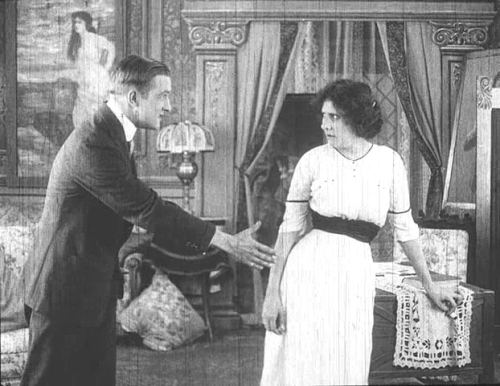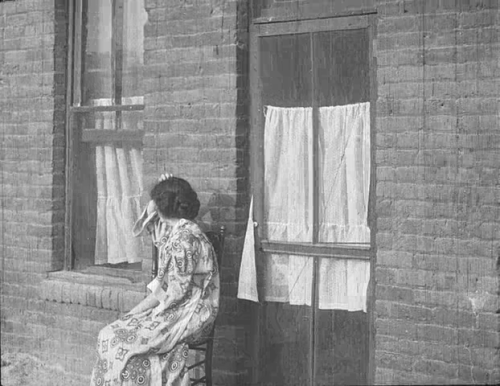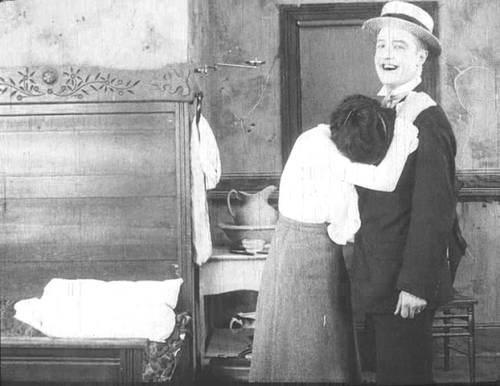THE INSIDE OF THE WHITE SLAVE TRAFFIC

IMDB
Título original: The Inside of the White Slave Traffic
Director: Frank Beal
Año: 1913
País: USA
Guion: Frank Beal, Samuel H. London
Intérpretes: Ninita Bristow, Edwin Carewe, Virginia Mann, Elinor O. Peterson, Jean Thomas
Producción: Moral Feature Film Co.
Duración: 28 min.
Argumento: The Inside of the White Slave Traffic” mira a los métodos empleados por un grupo de proxenetas para esclavizar a mujeres desprevenidas a una vida de prostitución, e incluso cuenta con un práctico glosario de argot inglés. La trata de blancas era un tema especialmente fuerte en 1913, el mismo año que la Universal lanzó “Traffic in Souls”, otra película importante que trataba la misma cuestión. Como Richard Koszarski menciona en sus notas de programa para la película, la producción de “The Inside of the White Slave Traffic” fue supervisada por un investigador federal, Samuel H. Londres, que vio la película como una oportunidad para crear conciencia sobre los peligros de la prostitución, teniendo una visión sombría en su descripción del tema.



Datos Técnicos:
 1913 - The Inside of the White Slave Traffic (Frank Beal).mkv
1913 - The Inside of the White Slave Traffic (Frank Beal).mkv 
He traducido los intertítulos al español:
 http://www.subdivx.com/X6XMzI2OTA3X-the ... -1913.html
http://www.subdivx.com/X6XMzI2OTA3X-the ... -1913.html
Publicada por wallyrcarp en surrealmoviez y ripeo de TinyBear
Carl Bennett:
[quote] This early exploitation film, produced under the guise of a reformist social drama, has garnered a somewhat exaggerated reputation over the years. While The Inside of the White Slave Traffic (1913) is populated with the early 20th century versions of pimps and prostitutes, they are present by knowing implication rather than by overt expression. As would be expected, whether in modern or contemporary times, the salaciousness of the film exists far more in the mind than in the reality of the action.
Establishing first the day-to-day life of white slave procurer George Fischer (Edwin Carewe), the film then follows the unfortunate descent of Annie (Virginia Mann), a “good girl,” into the underworld of sexual slavery. Jettisoned by her shamed, moralist father and abandoned by her seducer, Annie is duped by pimp Sam Brand into traveling to New Orleans, where she is coerced into prostitution. She defiantly escapes her pimp by fleeing to Denver, but Annie is blacklisted by the underground system. In Houston it is the same story. She is eventually easily traced by Sam and is drawn back into the world of prostitution, but she is soon arrested, jailed and rehabilitated.
Now working a legitimate job as a clerk in a department store, Annie is soon distressed by her low pay and returns to Sam and a life of ongoing prostitution. Surviving prints of the film then jump to her inevitable demise, anonymously buried in a pauper’s cemetary.
While surviving prints of the film are spare of plot, we can reasonably assume that there originally was more substance to the tale of this four-reel feature film.
We love the documentary quality of the scenes that were shot on the streets of New York City. The people are those of the neighborhood, with daytime bustling around them, elevated trains, and rows of businesses. Shots of storefronts invite close scrutiny of signage and products that were commonplace then and a historical curiosity now. Now and again, one’s attention may be spirited away by examination of a gate railing or a chewing gum dispenser, no longer manufactured in its fashion and rarely seen today in its original historical context.
While some independent silent era productions were painfully hampered by a shortage of talent and meagre budgets, The Inside of the White Slave Traffic can still be entertaining and enjoyed by today’s audiences. The storyline, while predictable to modern viewers, is serviceable and the film’s production values are of average quality for its time. [/quote]
Saludos

IMDB
Título original: The Inside of the White Slave Traffic
Director: Frank Beal
Año: 1913
País: USA
Guion: Frank Beal, Samuel H. London
Intérpretes: Ninita Bristow, Edwin Carewe, Virginia Mann, Elinor O. Peterson, Jean Thomas
Producción: Moral Feature Film Co.
Duración: 28 min.
Argumento: The Inside of the White Slave Traffic” mira a los métodos empleados por un grupo de proxenetas para esclavizar a mujeres desprevenidas a una vida de prostitución, e incluso cuenta con un práctico glosario de argot inglés. La trata de blancas era un tema especialmente fuerte en 1913, el mismo año que la Universal lanzó “Traffic in Souls”, otra película importante que trataba la misma cuestión. Como Richard Koszarski menciona en sus notas de programa para la película, la producción de “The Inside of the White Slave Traffic” fue supervisada por un investigador federal, Samuel H. Londres, que vio la película como una oportunidad para crear conciencia sobre los peligros de la prostitución, teniendo una visión sombría en su descripción del tema.



Datos Técnicos:
- Spoiler: mostrar
He traducido los intertítulos al español:
Publicada por wallyrcarp en surrealmoviez y ripeo de TinyBear
Carl Bennett:
[quote] This early exploitation film, produced under the guise of a reformist social drama, has garnered a somewhat exaggerated reputation over the years. While The Inside of the White Slave Traffic (1913) is populated with the early 20th century versions of pimps and prostitutes, they are present by knowing implication rather than by overt expression. As would be expected, whether in modern or contemporary times, the salaciousness of the film exists far more in the mind than in the reality of the action.
Establishing first the day-to-day life of white slave procurer George Fischer (Edwin Carewe), the film then follows the unfortunate descent of Annie (Virginia Mann), a “good girl,” into the underworld of sexual slavery. Jettisoned by her shamed, moralist father and abandoned by her seducer, Annie is duped by pimp Sam Brand into traveling to New Orleans, where she is coerced into prostitution. She defiantly escapes her pimp by fleeing to Denver, but Annie is blacklisted by the underground system. In Houston it is the same story. She is eventually easily traced by Sam and is drawn back into the world of prostitution, but she is soon arrested, jailed and rehabilitated.
Now working a legitimate job as a clerk in a department store, Annie is soon distressed by her low pay and returns to Sam and a life of ongoing prostitution. Surviving prints of the film then jump to her inevitable demise, anonymously buried in a pauper’s cemetary.
While surviving prints of the film are spare of plot, we can reasonably assume that there originally was more substance to the tale of this four-reel feature film.
We love the documentary quality of the scenes that were shot on the streets of New York City. The people are those of the neighborhood, with daytime bustling around them, elevated trains, and rows of businesses. Shots of storefronts invite close scrutiny of signage and products that were commonplace then and a historical curiosity now. Now and again, one’s attention may be spirited away by examination of a gate railing or a chewing gum dispenser, no longer manufactured in its fashion and rarely seen today in its original historical context.
While some independent silent era productions were painfully hampered by a shortage of talent and meagre budgets, The Inside of the White Slave Traffic can still be entertaining and enjoyed by today’s audiences. The storyline, while predictable to modern viewers, is serviceable and the film’s production values are of average quality for its time. [/quote]
Saludos


